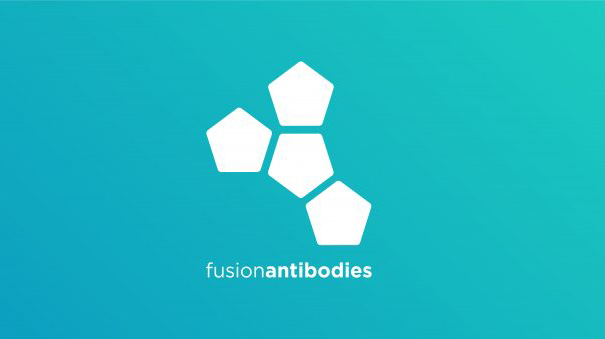A refresh of one of the world’s most recognised Antibody Humization brands with updates to the iconic antibody mark and a design language that allows the brand to live outside of the lab.
Fusion Antibodies is one of the world’s most trusted and leading Humization brands. Kaizen Brand Evolution has refreshed the Fusion Antibodies visual identity, reasserting and amplifying the brand’s visual expression. The project sought to re-assert the antibody logo, introduced many years before becoming a PLC, and to derive a typographic language that could communicate effectively. The refresh was initiated as part of a larger branding project that covered a full re-design of the Fusion Antibodies website, internal and external facing brand.
One of the primary goals was to reinvigorate the brand identity and optimise the brand for online customers across the world. Fusion Antibodies has a global reach that is viewed on multiple digital platforms and the identity refresh allows for this expansion and scale. The new visual identity brings strength and simplicity to the brand enabling Fusion Antibodies to voice their experience and services.
Kaizen Brand Evolution worked closely with on the project with senior management and stakeholders at Fusion Antibodies. The challenge for the designers was to translate results from a series of workshop answers created from multiple team members on what the business means to them. The designers had to strengthen a recognised brand for a global audience, crossing language barriers in a digital world.
The logo and secondary brands have been redrawn to thrive across brand areas on and offline, at different sizes and scales. The brand typography has been carefully resolved to be more legible and effective across contexts such as the Fusion Antibodies website on desktop and mobile, signage and conference stands. The graphic system along with the colour palette is flexible, engaging and highlights the personality of the brand. The pentagons extend through the applications, including brand stationery, signage, marketing material and the website. The supporting typography is set in the modern sans serif Gotham Pro.
Throughout the branding the use of gradients and pentagons allows information to breathe and be digested, this is especially useful on the website where content is plenty. Kaizen Brand Evolution developed the brand messaging, which was created to engage key clients and create a cohesive voice for services and future activity as the business grows.
The team created the Fusion Antibodies website from the ground up, utilising creative elements for the refreshed brand identity and typographic system. The colour palette and pentagon shapes enhance the brand expression in digital platforms. Each page on the site has been meticulously designed to suit the content and talk to the customer on their level without any confusion. We sought out to create a useable, informative customer journey from enquiry to sale. The team worked closely with senior marketing at Fusion Antibodies in the customer journey, sitemap and pipeline.
As Fusion Antibodies continues to evolve so does our creative relationship with them. Antibody Humization is an extremely important field for human kind and we are grateful to have created this important identity.

